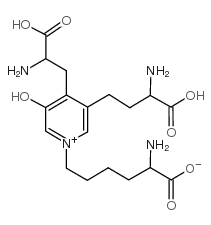83462-55-9
| Name | (2R)-2-amino-6-[4-[(2S)-2-amino-2-carboxyethyl]-3-[(3S)-3-amino-3-carboxypropyl]-5-hydroxypyridin-1-ium-1-yl]hexanoate |
|---|---|
| Synonyms |
(2r)-2-amino-6-{4-[(2s)-2-amino-2-carboxyethyl]-3-[(3s)-3-amino-3-carboxypropyl]-5-hydroxypyridinium-1-yl}hexanoate
Lysylpyridinoline N-(5-Amino-5-carboxypentyl)-3-hydroxy-4-(2-amino-2-carboxyethyl)-5-(3-amino-3-carboxypropyl)pyridine (2R)-2-amino-6-[3-[(3S)-3-amino-4-hydroxy-4-oxobutyl]-4-[(2S)-2-amino-3-hydroxy-3-oxopropyl]-5-hydroxypyridin-1-ium-1-yl]hexanoate Deoxypyridinoline |
| Description | Deoxypyridinoline is an endogenous metabolite present in Urine that can be used for the research of Heart Failure[1][2]. |
|---|---|
| Related Catalog | |
| In Vitro | Endogenous metabolites is defined as those that are annotated by Kyoto Encyclopedia of Genes and Genomes as substrates or products of the ~1900 metabolic enzymes encoded in our genome. It is clear in the body of literature that there are documented toxic properties for many of these metabolites[1]. |
| References |
| Molecular Formula | C18H28N4O7 |
|---|---|
| Molecular Weight | 412.43800 |
| Exact Mass | 412.19600 |
| PSA | 216.90000 |
